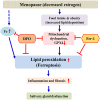Effect of deferoxamine and ferrostatin-1 on salivary gland dysfunction in ovariectomized rats
- PMID: 37036468
- PMCID: PMC10120905
- DOI: 10.18632/aging.204641
Effect of deferoxamine and ferrostatin-1 on salivary gland dysfunction in ovariectomized rats
Abstract
The mechanism underlying xerostomia after menopause has not yet been fully elucidated. This study aimed to investigate the mechanism of xerostomia and the effect of the ferroptosis inhibitors deferoxamine (DFO) and ferrostatin-1 (FER) on salivary gland dysfunction in a postmenopausal animal model. Twenty-four female Sprague-Dawley rats were randomly divided into four groups: a SHAM group (n = 6, sham-operated rats), an OVX group (n = 6, ovariectomized rats), an FER group (n = 6, ovariectomized rats injected intraperitoneally with FER), and a DFO group (n = 6, ovariectomized rats injected intraperitoneally with DFO). GPX4 activity, iron accumulation, lipid peroxidation, inflammation, fibrosis, and salivary gland function were analyzed. Recovery of GPX4 activity and a decrease in iron accumulation and cytosolic MDA + HAE were observed in the DFO group. In addition, collagen I, collagen III, TGF-β, IL-6, TNF-α, and TGF-β levels were decreased in the DFO group compared to the OVX group. Recovery of GPX4 activity and the morphology of mitochondria, and reduction of cytosolic MDA + HAE were also observed in the FER group. In addition, decreased expression of inflammatory cytokines and fibrosis markers and increased expression of AQP5 were observed in both the DFO and FER groups. Postmenopausal salivary gland dysfunction is associated with ferroptosis, and DFO and FER may reverse the postmenopausal salivary gland dysfunction after menopause. DFO and FER are hence considered promising treatments for postmenopausal xerostomia.
Keywords: deferoxamine; ferroptosis; ferrostatin-1; menopause; xerostomia.
Conflict of interest statement
Figures







Similar articles
-
The mechanism of submandibular gland dysfunction after menopause may be associated with the ferroptosis.Aging (Albany NY). 2020 Nov 5;12(21):21376-21390. doi: 10.18632/aging.103882. Epub 2020 Nov 5. Aging (Albany NY). 2020. PMID: 33159020 Free PMC article.
-
Ferrostatin-1 Ameliorates Liver Dysfunction via Reducing Iron in Thioacetamide-induced Acute Liver Injury in Mice.Front Pharmacol. 2022 Apr 12;13:869794. doi: 10.3389/fphar.2022.869794. eCollection 2022. Front Pharmacol. 2022. PMID: 35496274 Free PMC article.
-
Effect of Echinochrome A on Submandibular Gland Dysfunction in Ovariectomized Rats.Mar Drugs. 2022 Nov 22;20(12):729. doi: 10.3390/md20120729. Mar Drugs. 2022. PMID: 36547876 Free PMC article.
-
Restoring the secretory function of irradiation-damaged salivary gland by administrating deferoxamine in mice.PLoS One. 2014 Nov 26;9(11):e113721. doi: 10.1371/journal.pone.0113721. eCollection 2014. PLoS One. 2014. PMID: 25427160 Free PMC article.
-
[Hippocampal neuronal ferroptosis involved in cognitive dysfunction in rats with sepsis-related encephalopathy through the Nrf2/GPX4 signaling pathway].Zhonghua Wei Zhong Bing Ji Jiu Yi Xue. 2019 Nov;31(11):1389-1394. doi: 10.3760/cma.j.issn.2095-4352.2019.11.015. Zhonghua Wei Zhong Bing Ji Jiu Yi Xue. 2019. PMID: 31898571 Chinese.
Cited by
-
Ferroptosis in organ fibrosis: From mechanisms to therapeutic medicines.J Transl Int Med. 2024 Mar 21;12(1):22-34. doi: 10.2478/jtim-2023-0137. eCollection 2024 Feb. J Transl Int Med. 2024. PMID: 38525436 Free PMC article.
-
Ferroptosis and Metabolic Dysregulation: Emerging Chemical Targets in Cancer and Infection.Molecules. 2025 Jul 18;30(14):3020. doi: 10.3390/molecules30143020. Molecules. 2025. PMID: 40733290 Free PMC article. Review.
-
TGFβ2-Driven Ferritin Degradation and Subsequent Ferroptosis Underlie Salivary Gland Dysfunction in Postmenopausal Conditions.Adv Sci (Weinh). 2024 Dec;11(47):e2400660. doi: 10.1002/advs.202400660. Epub 2024 Nov 1. Adv Sci (Weinh). 2024. PMID: 39481440 Free PMC article.
-
Amifostine and Melatonin Prevent Acute Salivary Gland Dysfunction 10 Days After Radiation Through Anti-Ferroptosis and Anti-Ferritinophagy Effects.Int J Mol Sci. 2024 Oct 29;25(21):11613. doi: 10.3390/ijms252111613. Int J Mol Sci. 2024. PMID: 39519165 Free PMC article.
-
Combination decoction of Astragalus mongholicus and Salvia miltiorrhiza mitigates pressure-overload cardiac dysfunction by inhibiting multiple ferroptosis pathways.Front Pharmacol. 2024 Dec 16;15:1447546. doi: 10.3389/fphar.2024.1447546. eCollection 2024. Front Pharmacol. 2024. PMID: 39737072 Free PMC article.
References
-
- Fitzmaurice C, Akinyemiju TF, Al Lami FH, Alam T, Alizadeh-Navaei R, Allen C, Alsharif U, Alvis-Guzman N, Amini E, Anderson BO, Aremu O, Artaman A, Asgedom SW, et al., and Global Burden of Disease Cancer Collaboration. Global, Regional, and National Cancer Incidence, Mortality, Years of Life Lost, Years Lived With Disability, and Disability-Adjusted Life-Years for 29 Cancer Groups, 1990 to 2016: A Systematic Analysis for the Global Burden of Disease Study. JAMA Oncol. 2018; 4:1553–68. 10.1001/jamaoncol.2018.2706 - DOI - PMC - PubMed
Publication types
MeSH terms
Substances
LinkOut - more resources
Full Text Sources
Medical

